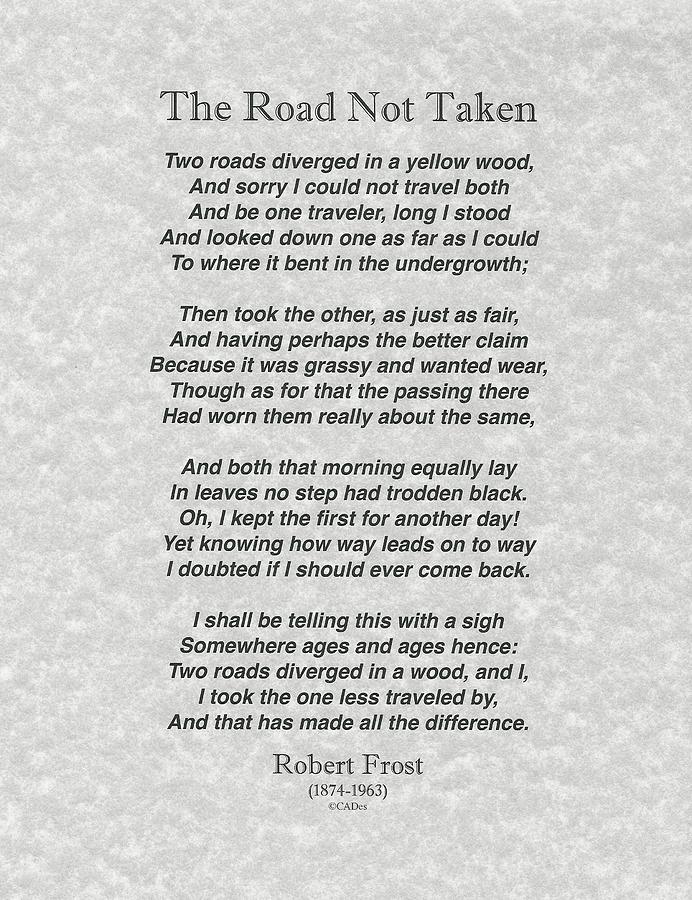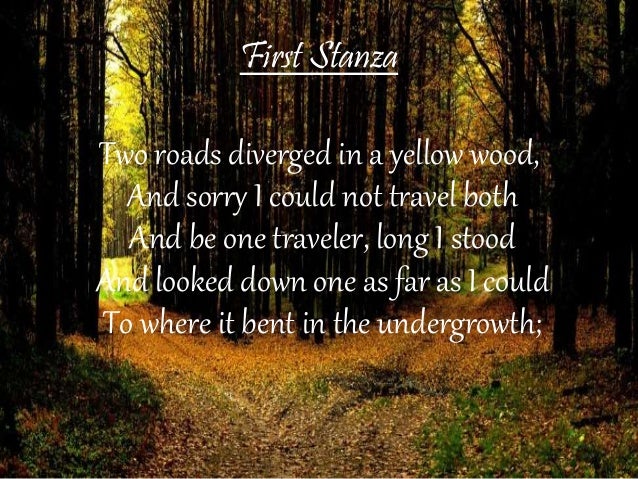

The first stanza of the poem establishes the setting and the mood of the poem. By analyzing the poem through each of its four stanzas, one can begin to trace the linguistic tools used by the author to make his meaning clear.

As Bellah (2004) points out, the title of the poem is “The Road Not Taken” rather than “The Road Less Taken” (emphasis added), which provides the first clue as to the author’s original intentions and a different reading of the poem. While this interpretation has plenty of validity to it, it is not necessarily supported by the text any more than Frost’s comment about the poem being tricky serves to increase confidence that there is only one valid interpretation of the poem. As has been indicated, “most people seem to interpret this poem as a tribute to the road less traveled, as an endorsement of the decision to plow new ground, to explore new territory, to try or to create something new” (Bellah, 2004). While the poem is making a connection between Frost’s walks in the woods and the journey through life, the connection he was making was quite different from prescribing a particular path to follow. However, for most, the beautiful scenery the poem conjures up – the ‘yellow wood’, the ‘undergrowth’, the ‘grassy’ way and the fresh leaves that ‘wanted wear’ – causes them to pause here and reflect that Frost himself took the road ‘less traveled by’, assuming he is recommending this as the best course of action for everyone.Ī close reading of the poem reveals that this is merely a trick of the light, so to speak. Thus, when Frost discusses taking a walk in the woods and coming to a place where a choice must be made, the reader has already made the jump, deep within their mind, that this poem must have something to say about life. “Accordingly, we talk about things the way we conceive of them, and this is fashioned through and grounded in experience and culture: our basic conceptual system ‘is fundamentally metaphoric in nature’” (Bailey, 2003). In other words, we are only able to discuss our ideas and beliefs with others through the use of the conceptual metaphor, which requires a shared language and cultural base and serves as a means by which we define ourselves. “Lakoff and Johnson revealed, through theoretical argument supported by empirical investigation, the centrality of metaphor to thought exemplified in the ubiquity of metaphorical forms in everyday, conventional language” (Bailey, 2003). It is an idea that is brought forward by Lakoff and Johnson that illustrates that this connection is made at such a deep level that it cannot be avoided. Generally speaking, a conceptual metaphor is defined as a metaphor “that is so basic in the way people think about something that they fail to perceive that it is a metaphor” (“Conceptual Metaphor”, 2007). The conceptual metaphor that links ‘life’ with ‘journey’ is culturally ingrained in nearly every Western-born individual. According to Larry Finger (1978), he once told an audience, “You have to be careful of that one it’s a tricky poem – very tricky” when referring to “The Road Not Taken.” While the conceptual metaphor still applies, a close reading of the textual cues of the poem indicate that Frost is not recommending which road should be selected, only providing a warning that, once selected, it is impossible to know what might have been missed on the other way. It isn’t bad advice, but it isn’t exactly what Frost had in mind when he wrote it. Pulling from the conceptual metaphor that life is a journey, this essentially translates to the concept that individuals should strive to follow their own path in life rather than attempting to follow the paths that have been mapped out for them by others. An example of this is the mistaken concept by many people that Frost is recommending they take the road less traveled by as a means of living an independent and happy lifestyle. Most people reading Robert Frost’s poetry get so caught up in the beautiful imagery of the Vermont landscape that they forget to pay attention to the deep meaning he typically embedded within his poems.


 0 kommentar(er)
0 kommentar(er)
